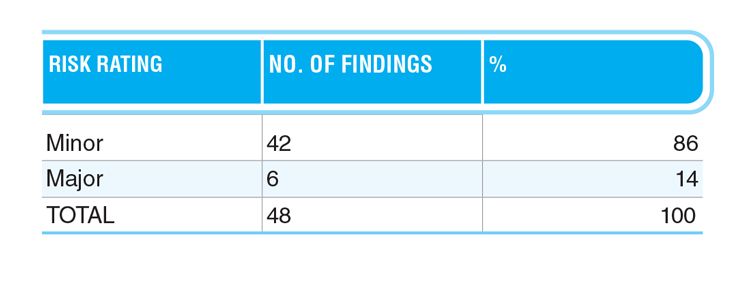HOME > ENVIRONMENT STABILITY
The environment constantly undergoes multiple changes, changes that are occurring over different temporal and spatial scales. As a result, it is vital that natural resources are managed in a sustainable manner. Adequate supplies of raw water resources are paramount to uMngeni-uThukela Water, which together with reliable sources of energy, water treatment chemicals and other resources are crucial for sustainability of the water business.
The entity, therefore, is steadfast in protecting, conserving and using and sustaining these resources efficiently.
Environmental management programmes and plans are embedded in all components of the water business lifecycle, namely, during planning, construction, operation and decommissioning. uMngeni-uThukela Water has classified its environmental management programmes as Corporate, Operational or Integrated Environmental Management:
uMngeni-uThukela Water, as a public water services entity in South Africa, complies with all mandatory environmental disclosure requirements. Notwithstanding this, the entity continues to improve alignment of environmental indicators with other national and internationally accepted indicator disclosure requirements, King IV Report on Corporate Governance, in terms of materiality and relevance. Relevant aspects include materials, including chemicals and water resources, energy efficiency, greenhouse gas emissions, carbon footprint mapping, biodiversity and waste management.
uMngeni uThukela Water leverages water sector partnerships and collaborations to respond to the challenges facing the region including water availability, redistribution,
demand management and drought and impact of climate change. Its core business function is to treat and supply bulk potable water – a business highly dependent on the availability of sustainable water resources. The reconciliation between water resource
availability and water demand is, therefore, of primary importance to the entity and forms an integral part of the infrastructure planning process. Understanding what water resources are available to the entity, both current and future resources, and what factors affect the assurance level of these resources is crucial to balancing supply with customer demand and maintaining supply sustainability into the future.
The primary water sources used by the entity is distributed across four major water resource systems, namely, the Mgeni System (Mooi and Mgeni rivers), the North Coast System (uMdloti, iMvutshane, uThukela and uMvoti rivers) and the South Coast System (Nungwane, Mzimayi, uMuziwezinto and Mhlabatshane rivers). Total water withdrawal by source is shown in the below graph. In addition, UUW is currently installing equipment to monitor the water resources in the KCDM area as this installation will enable efficient management of the water resources in the area.
Water Withdrawal by Source (million m3)
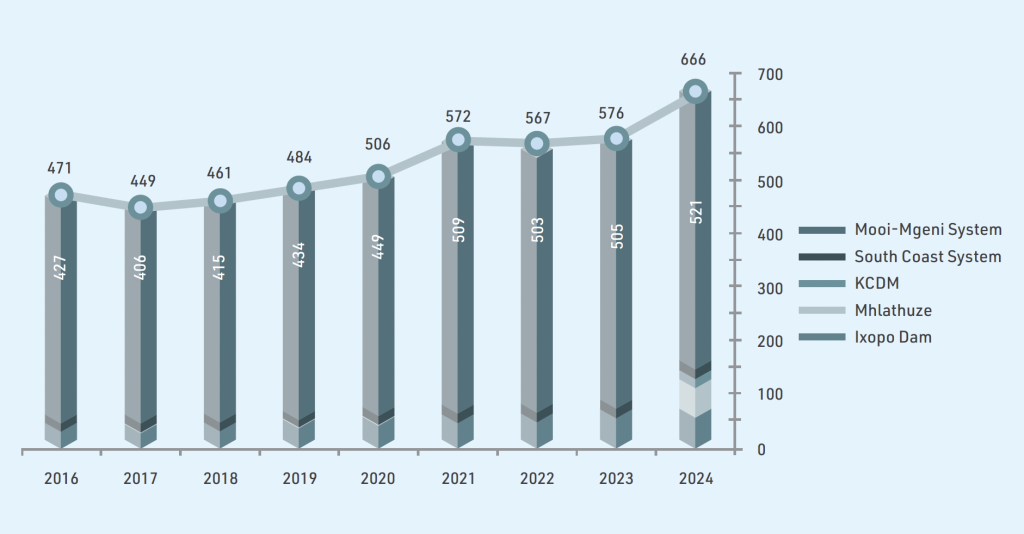
In the reporting period, progress was made with the following water resource dam developments:
The natural climate is the prime determinant of water resources availability, whether surface or groundwater. Sufficient water that is fit for purpose is key to the business of uMngeni-uThukela Water. During the year under review, uMngeni-uThukela Water implemented the organisational Climate Change Response Policy. The main purpose of the policy is to provide a framework for uMngeni-uThukela Water’s just transition to a climate resilient and lower carbon water entity. The objectives of the policy are to:
During 2023/2024 a climate change implementation plan was implemented. This plan is integrated to the overarching uMngeni-uThukela Water sustainability implementation plan and incorporates targets for both mitigation and adaptation
responses, where the mitigation targets are aimed at reducing the organisation’s greenhouse gas emission, while the adaptation initiatives responds directly to water resource and water supply sustainability and are aimed at buiding the organisation’s resilience to the current and protected impacts of climate change which includes reduced streamflow, extreme weather events (wet spells and dry spells), poor water quality, catchment degradadtion and ecological collase.
The climate mitigation interventions that were implemented during the period under review included carbon emissions reduction related practices such as monitoring energy usage, water usage, undertaking a feasibility study for the solar power insallation at seven (7) uMngeni-uThukela Water sites; undertaking a feasibility study for the Darvill WWTWs co-generation; appointment of service provider to undertake detailed feasibility of the Mpofana Hydropower installation; and implementation of ecological infrastructure interventions that have benefts for climate regulation and carbon sequestration.
The implemented adapatation interventions on the other hand, included the monitoring drought paramaters; monitoring of flood parameters; development and implementation of an annual flood drill plan; issuing of flood early warnings to various operational sites; communication of weekly water resource status updates on various digital media plartforms; installation of automated river level monitoring equipments at various sites; setting up of a hydronet subscription for hydro alerts and maps that will be integrated into the flood forecasing and early warning system; calibration of hydraulic model for the flood forecasting and early warning system; setting up of a web-based dashboard for viewing the flood early warning system by external users; development and implementation of water safety plans for water quality management; implementation of catchment management and ecological infrastructure interventions that support water quality enhancement and sustainable water supply.
In terms of climate change related stakeholder engagement, during 2023/2024, uMngeni-uThukela Water actively participated at the KwaZulu-Natal Climate Change Committee quarterly meetings that are chaired by the Department of Economic Development, Tourism and Environmental Affairs who is the regurator for climate change in SA. UUW participated at the the KZN SALGA Climate Change Compact to create awareness on the interventions that are implemented by the organitation. Two (2) climate change sector department trainitions were attended by uMngeni-uThukela Water, one on the climate change response strategy for the water and sanitation which included incorporation of climate change on to water safety plans and the other on green economy and just transition.
uMngeni-uThukela Water (UUW) is operating a water recovery plant at its Darvill Wastewater Treatment Works (WWTW)). The 2 Ml/d plant comprises a conventional wastewater treatment plant to provide process water for the Darvill WWTP, followed by an advanced tertiary treatment plant. The plant is being used for evaluating the effectiveness of reuse processes and for demonstrating to communities the benefits of wastewater reuse to applicable potable water standards. Recently UUW completed a WRC study, which successfully illustrated the effectiveness of the plant in producing potable water complying with the South African National Standard Drinking Water specification (SANS 241:2015). Partnerships are now being developed with various Universities i.e. Venda and UNISA, to utilise this facility for further research.
The status of raw water quality per resource is shown in Table 11.1 and Figure 11.2. Water quality risks in uMngeni-uThukela Water supply catchments arise from factors including: eutrophication (nutrient enrichment and its associated threats including algal blooms, taste and odours and aquatic weed infestations), faecal contamination and associated pathogen risks, suspended solids and chemical constituents (including iron and manganese). This impacts on treatability, chemical usage and other cost implications, and may contribute to final water non-compliance with the South African National Standard Drinking Water specification (SANS 241: 2015). Source and raw water quality monitoring is undertaken to assess and mitigate treatability risks, optimise raw water quality and provide early warning of adverse raw water quality that can be expected at the water treatment works.
Resource Water Quality



Catchment water quality management plans include:
The Department of Water and Sanitation (DWS), as the custodian of South Africa’s water resources, is kept informed of the quality, trends and potential risks associated with raw water resources.
In response to the water quality issues highlighted under the raw water quality section, uMngeni-uThukela Water implements an integrated catchment management program. The interventions that were implemented during 2023/2024 are shown in Table 11.2.
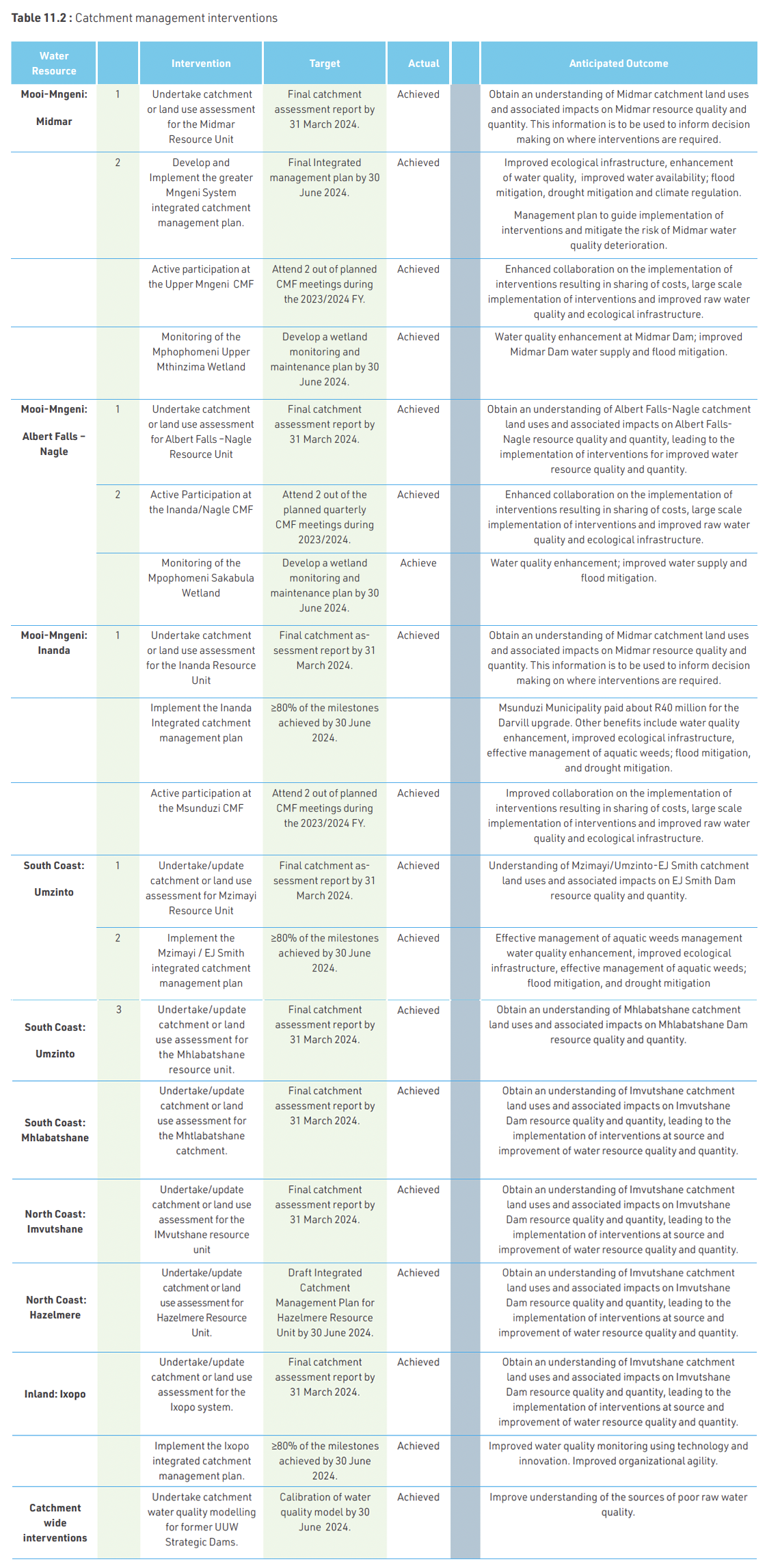
uMngeni-uThukela Water strives to use the water abstracted from resources assiduously. Water balancing and water loss management measures are in place per treatment system. Overall, water loss levels have been maintained below the entity’s target level of 5% over the years. Water loss trends are shown below.
Water Losses
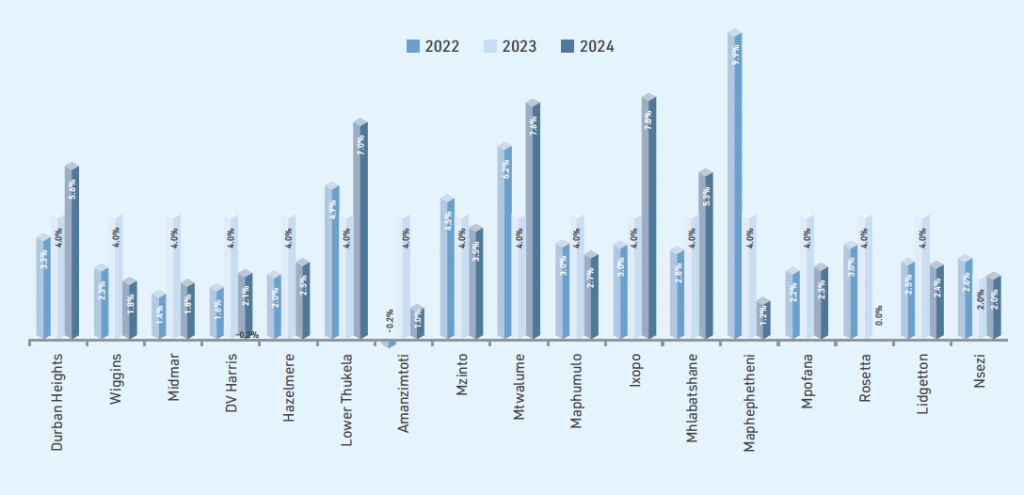
Water is the most significant input material for uMngeni-uThukela Water, as described in the previous section, followed by energy, which is discussed below. In addition, uMngeni-uThukela Water has a high reliance on water treatment chemical resources and is, therefore, committed to improving the usage efficiency thereof.
The chemical usage trend for the past five years is presented in Figure 11.4. During the current assessment period, uMngeniuThukela Water utilised a total of 11.8 million kg of water treatment chemicals. A notable increase in chemical usage was observed compared to the previous year. This escalation is likely due to the need to treat larger volumes of raw water of suboptimal quality, a consequence of catchment activities, as well as the operation of additional plants and the expansion of our operational footprint. The use of water treatment chemicals was essential to ensuring that potable water consistently met the required quality standards and maintained these standards up to the point of use.
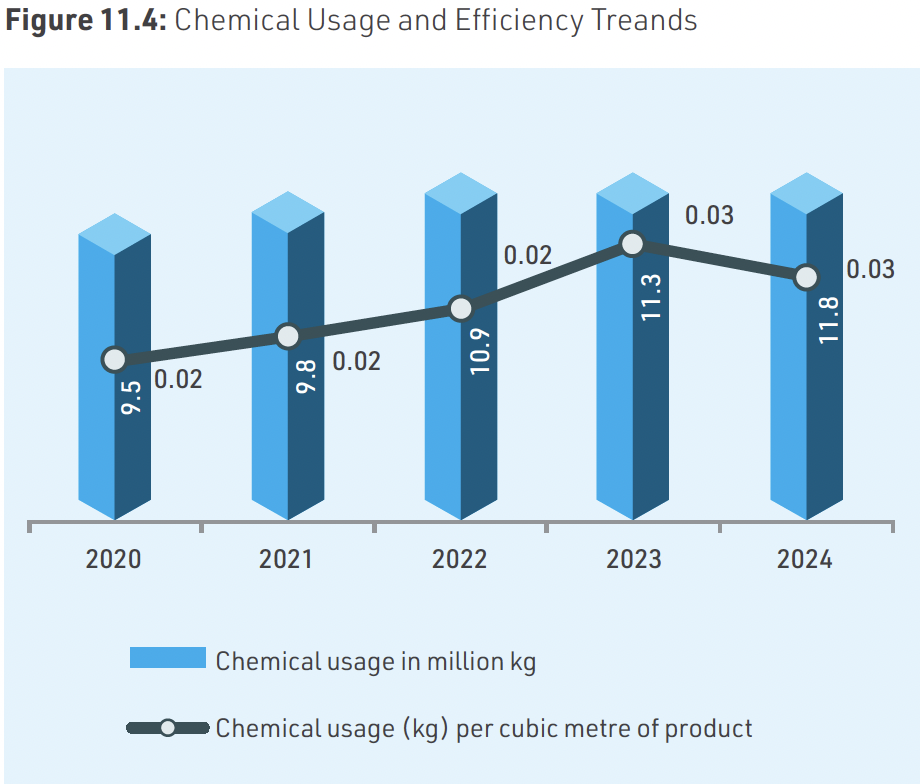
uMngeni-uThukela Water has implemented various initiatives to optimise the use of water treatment chemicals. These include:
Carbon footprint can be described as the total amount of carbon dioxide and other greenhouse gas (GHG) emissions (expressed as carbon dioxide equivalents or CO2e) for which an organisation or site is responsible for or has control over, resulting from business activities. The entity’s carbon emissions are shown in Figure 11.5.
uMngeni-uThukela Water wants to take full ownership of all emissions that it can control, influence and reduce. Scope 1 emissions refer to direct emissions that the organisation can control, whereas scope 2 and 3 emissions are indirect emissions controlled by third party organisations.
Table 11.3 shows the GHG Emissions for scopes 1, 2 and 3 where increament is notable in association with expansion of the operational area. uMngeni-uThukela Water’s direct CO2 emission (Scope 1) contributions emanate mainly from vehicles, boats, generators and methane production from anaerobic wastewater treatment process
(Figure 11.5). Indirect GHG emissions are predominantly due to electricity consumption (>99%) which is one of the main inputs to water and wastewater treatment processes. (Table 11.3).
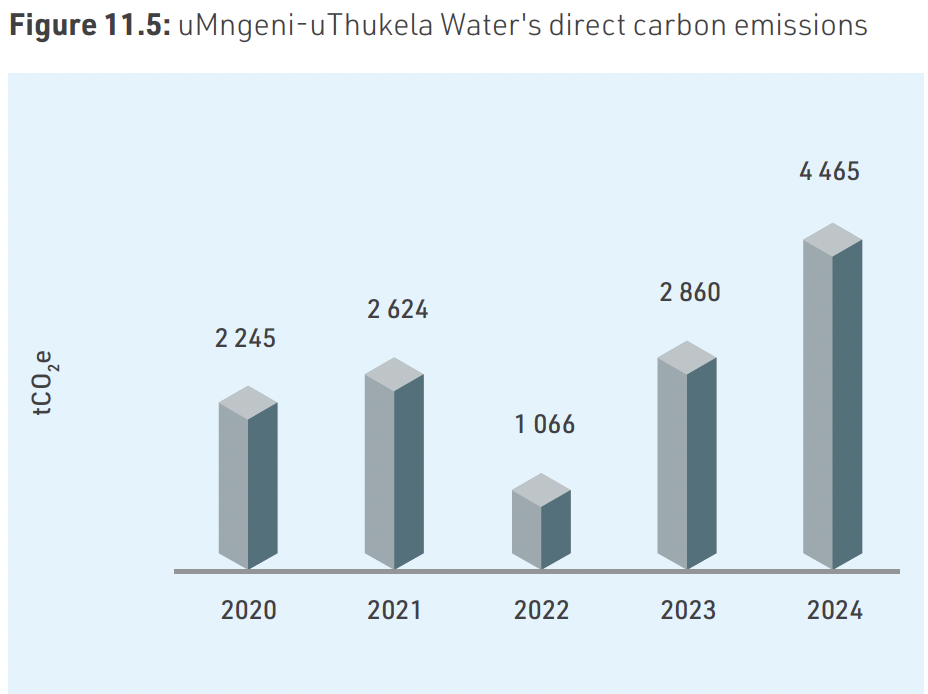
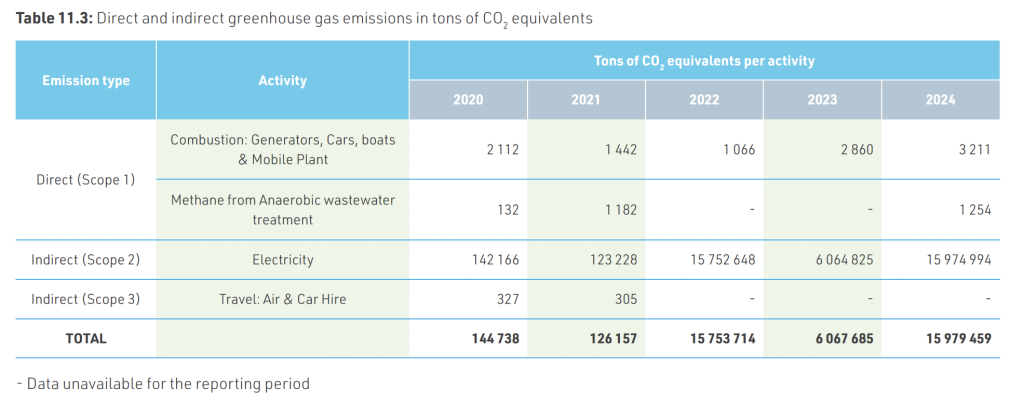
uMngeni-uThukela Water is in the process of investigating and implementing sustainable initiatives to reduce its carbon footprint. The main initiative that is proposed for implementation is the development of an electricity cogeneration plant at Darvill WWTW that will utilise the methane produced at this plant to produce electricity. Preliminary studies indicate that energy produced from this system can reduce the Darvill WWTW’s energy demand by approximately 40%. Other initiatives to reduce and offset the organisation’s emissions form part of the organisation’s Environmental Sustainability Plan.
uMngeni-uThukela Water’s objective of greening its operational and future infrastructure is driven and supported by its desire to shift towards environmental sustainability. Green buildings not only reduce or eliminate negative impacts on the environment by using less water, energy or natural resources, but may also have a positive impact on the environment by generating their own energy or by increasing biodiversity. Key drivers of the need for green building include climate change, energy, water security, waste reduction, healthy working environments and biodiversity.
As a water utility, uMngeni-uThukela Water can play a significant role in the green building sector through its comprehensive Capital Expenditure Programme, which involves the provision of vital infrastructure required to enhance assurance of water supply. Therefore, uMngeni-uThukela Water has since developed a Green Building Policy with the following objectives:
This policy provides a framework to structure the approach to achieving sustainable design outcomes, commitment and minimum requirements for its implementation.
One of the projects that have been identified for Green Star Certification is the Lower uMkomaas Bulk Water Supply Scheme which is a scheme that will serve eThekwini Metropolitan Municipality and Ugu District Municipality. The planned infrastructure comprises the raw water infrastructure and the bulk water treatment works. The administration building situated at the water treatment works is earmarked for certification.
In 2019, uMngeni-uThukela Water Executive Committee and Board identified the deterioration in the quality of catchment or raw water resources and the associate impacts of climate change as a strategic risk. This deterioration impacts on the quality and quantity of raw water resources which are paramount to uMngeni-uThukela Water’s core business of sustainable water supply. Implications include supply limitation, high water treatment costs, high infrastructure design costs, decreased affordability of customers, non-payment for water services by customers and several other risks. The source of the problem of poor catchment health stems from several factors including, poor land use practices, poor mindset and behaviour of water users towards water resources, lack of pollution reduction/ prevention from source, lack of coordination of water resource management activities at catchment level, poor compliance monitoring and enforcement by regulators, lack of institutional capacity within the mandated departments for environmental and water resource protection and lack of integration between water users/stakeholders.
These issues are a symptom of a failure of traditional water resource management approaches in which water resource management was highly centralised and did not encourage an holistic approach to water resource management where there is:
In response to to the serious and urgent challenge of deterioration of catchment health, in 2019 uMngeni-uThukela Water established a Catchment Management unit within its scientific Services Division. The primary mandate of the newly established department is to implement catchment interventions that will improve water resource quality and availability trategic water supply catchments. Since water is shared resource among different users, efforts towards its effective management require coordination and collaboration between stakeholders in order to ensure effectiveness of interventions. The catchment management initiatives undertaken by uMngeni-uThukela Water during the 2023/2024 period are discussed below.
Catchment assessments are undertaken or updated on a annual basis to help improve the understanding of the different land use activities and other stressors that affect raw water quality and availability. During the period under review catchment assesssments and updates were undertaken for the following catchments:
Overall outcomes of the catchment assessments indicated that the main land use and water use types that affects catchment health within uMngeni-uThukela Water area of operation include discharges from waterwater treatment works; raw sewer discharges from poorly maintained sewer infrastructure; nutrient inputs from agricultural runoff; ecological/environmental degradation; poor solid waste management; extreme weather events; ecological infrastructure transformation to agricultural lands; poor development and spatial planning; urbanisation and the associated poor sanitation services; unsustainable agricultural practices; soil erosion; alien invasive plant infestation; industrial discharges or chemical spillages; illegal sand mining; and poor mindset and behaviour of water users towards water management. Biodiversity Management – Aquatic Alien Invasive Weeds Management Well-managed and sustainable water resources are critical to uMngeni-uThukela Water’s core function of providing sustainable water supply. Alien aquatic weeds invading various water resources pose a significant risk to water security. The aquatic weeds of main concern in uMngeni-uThukela Water impoundments and supply rivers include Water Hyacinth (Pntederia crassipes); Water lettuce (Pistia stratiotes); Kariba weed (Salvinia molesta); Parrots feather (Myriophyllum aquaticum) and Honwort (Ceratophyllum demersum). These free-floating and submerged aquatic alien invasive weeds are extremely difficult to control in eutrophic water resources due to their exponential growth rate. To ensure the effective management of these invasive weeds, interventions are implemented both in the upstream catchments as well as at the infested uMngeni-uThukela Water operated dams. An integrated approach adopted at both upstream catchments and at the infested dams, where a combination of biocontrol, manual removal and herbicide spraying is undertaken to ensure effective management of the weeds. In order to be effective, this work is undertaken in collaboration with key stakeholders including, communities, Community Based Organisation, Non-Governmetal Organisations, Non-Profit Organisations and the Department of Fisheries, Forestry and Environment’s (DFFE) Working for Water Programme.
The alien aquatic weeds management interventions undertaken during the period under review included:
Ecological infrastructure is defined as the nature-based equivalent of built or hard infrastructure. It refers to ecosystems that function naturally to deliver invaluable services to people and the environment including enhanced water quality and sustainable water supply, soil erosion management, climate regulation and disaster risk reduction. Ecological infrastructure includes catchments, rivers, wetlands, groundwater resources, inland and coastal areas, nodes and corridors of natural habitats, which together form a network of interconnected natural structural elements in the landscape.
Management and protection of ecological infrastructure ensures sustainable water availability, and therefore is as fundamental to uMngeni-uThukela Water’s business as engineered infrastructure development. uMngeni-uThukela Water’s initiatives on investment in ecological infrastructure are aligned to national government priorities and specified on the National Development Plan. This also include the key principles that guides investment in ecological infrastructure as recommended by the South African National Biodiversity Institute (SANBI ). The ecological infrastructure related initiatives undertaken by uMngeni-uThukela Water in the year include:
During the 2023/2024 financial year the following wetland management targets were achived to support sustainable water supply at strategic dams:
The Department of Water and Sanitation, uMngeni-uThukela Water and the Trans-Caledon Tunnel Authority are implementing the Mkhomazi-Mngeni Transfer Scheme to meet the current and future water demands of eThekwini Metro and surrounding areas. The major challenge is that the catchment upstream of the proposed Smithfield Dam in the uMkhomazi River is already highly degraded and a significant proportion of the remainder is at a high risk of future similar degradation. Technical experts have generated a number of scenarios related to the rate of sediment deposition that might occur in the proposed dam and the most reasonable scenario indicate that the dam would lose about half of its volume to sediment over 100 years.
In addition, highly turbid water due to sedimentation and siltation will contribute significantly to an increase in purification costs. Climate change, bringing both droughts and more intense rainfall events to this area, is likely to accelerate erosion and subsequent dam sedimentation and further increase turbidity. Population demographics for the uMkhomazi area show that 68% of people living in the area have no formal income and 10% earn less than R3 500 per month. Women are particularly vulnerable with 8 755 female-headed households of which about 3 492 are reliant on unprotected water sources. Many households survive by supplementing social grant and transfer payments with small-scale stock and crop production.
uMngeni-uThukela Water has partnered with with communities and stakeholders to share knowledge on practices that will lead to the restoration of the Upper Mkhomazi landscape. In addition to improving water security and reducing the cost of water treatment, this initiative creates significant direct and indirect economic opportunities to local residents and improve biodiversity with associated ecosystem benefits. However, it is anticipated that the benefits of successful conservation and restoration will, over the long term, far outweigh the costs. The dam itself (estimated cost at R30 billion) is likely to deliver limited local economic opportunities and most benefits benefits will accrue from upstream protection rather than from the dam itself. The first phase of the project was completed in 2020, phase 2 commenced in 2020 and was completed in in December 2023. Phase 3 is currently underway in collaboration with collaborators.
The overall objective of this project is use nature based solutions to address the severe land degradation and invasive alien plant infestation in the Upper Mkhomazi Catchment so as to improve water security, the livelihood prospects of local residents and biodiversity outcomes. This is being achieved through implementation of catchment management and ecological infrastructure interventions at degraded areas located upstream of the proposed Smithfield Dam. During 2023/2024 the following targets interventions were implemented:
The Ecological Infrastructure for water security project is a five year $7.2 million (approximately R90 million) worth investment from from the Global Environment Facility (GEF) with considerable cofinance from various collaboration with South African partners. The Department of Environmental Affairs is the National focal point for this project, the Development bank of South Africa (DBSA ) is the Implementing Agent for the GEF and SANBI is the project executing agency. The Project aims to transform the way people think about, value and invest in water and ecosystems, and will lead to increased investment in the management of ecological infrastructure in the future.
The project acknowledges the reality that, South Africa’s water security depends not only on our built water infrastructure, but also on well managed land and biodiversity ecosystems in our catchments. As such the project also recognises the urgent need to bring investment in the management, maintenance and restoration of ecosystems into the planning, financing and development in the water sector. It is antidipated that such investments will create more jobs and advance SA’s developmental agenda, especially in face of a changing climate. The EI4WS project is designed in close consultation with the Department of Water and Sanitation (DWS), and supports the implementation of the National Water Resource Strategy and the Call to Action of the Water and Sanitation Master Plan. Project implementation is through a suite of partnerships involving several other public, private and civil society organisations, such as the DWS,
the WRC, WWF-SA and uMngeni-uThukela Water.
The project was launched as a development finance institution with the ability to take the country’s natural capital into account in development financing.
As part of the signed collaboration agreement betwee uMngeniuThukela Water and SANBI, the following achievements were attained in the year under review:
The smart catchment management initiative that were undertaken during the period under review included undertaking calibration of the catchment water quality model; calibrating the hydraulic model of the flood early warning system; completing the hydronet system hydro-alerts configuration; establishing a Water Security Action Hub for Mobilising action towards water security and sustainable water supply; catchment parameter monitoring using citizen science tools in collaboration with Amanzi Champions; monitoring of aquatic weeds investation using satellite imagery and Unmanned Aerial Vehicles; and undertaking satellite based water quality monitoring at uMngeni-uThukela Water selected dams.
| Reserve / Site | Hectares Removed (Ha) |
|---|---|
| Albert Falls Dam | 545.71 |
| Spring Grove Dam | 98 |
| Hazelmere Dam | 95.56 |
| Inanda Dam | 183.45 |
| Nagle Dam | 521.2 |
| Mvutshane Dam | 148 |
| Nungwane Dam | 98 |
| Darvill WWTW | 54.88 |
| EJ Smith Dam | 37 |
| Mzinto Dam | 50.4 |
| Ixopo (Aquatics) | 28.5 |
| Mhlabatshane | 48 |
| Upper Mkomazi | 40 |
The National Water Act, Act No 36 of 1998 (NWA), requires that water-use licences are obtained before any water-use activity or development can be undertaken. Water use is defined as undertaking activities that have an impact on a water resource.
The impact may be on the amount of water in the resource, the quality of water in the resource and the environment surrounding the resource. Section 21 of the NWA lists 11 water uses as requiring a water-use licence before they can be undertaken. Of the 11 listed water uses, only seven (7) are applicable to uMngeni-uThukela Water and include:
Water users can include any entity or individual whose operations trigger the water uses that are listed in section 21 of the NWA. To ensure compliance with the requirements of the NWA, the water-use licence status and compliance was monitored and quarterly reporting was undertaken. This included developing and implementing action plans to obtain outstanding licences and compliance with the conditions of the existing authorisations.
The status of water use licence applications for CAPEX Projects (new infrastructure development projects) is presented in the figure below:
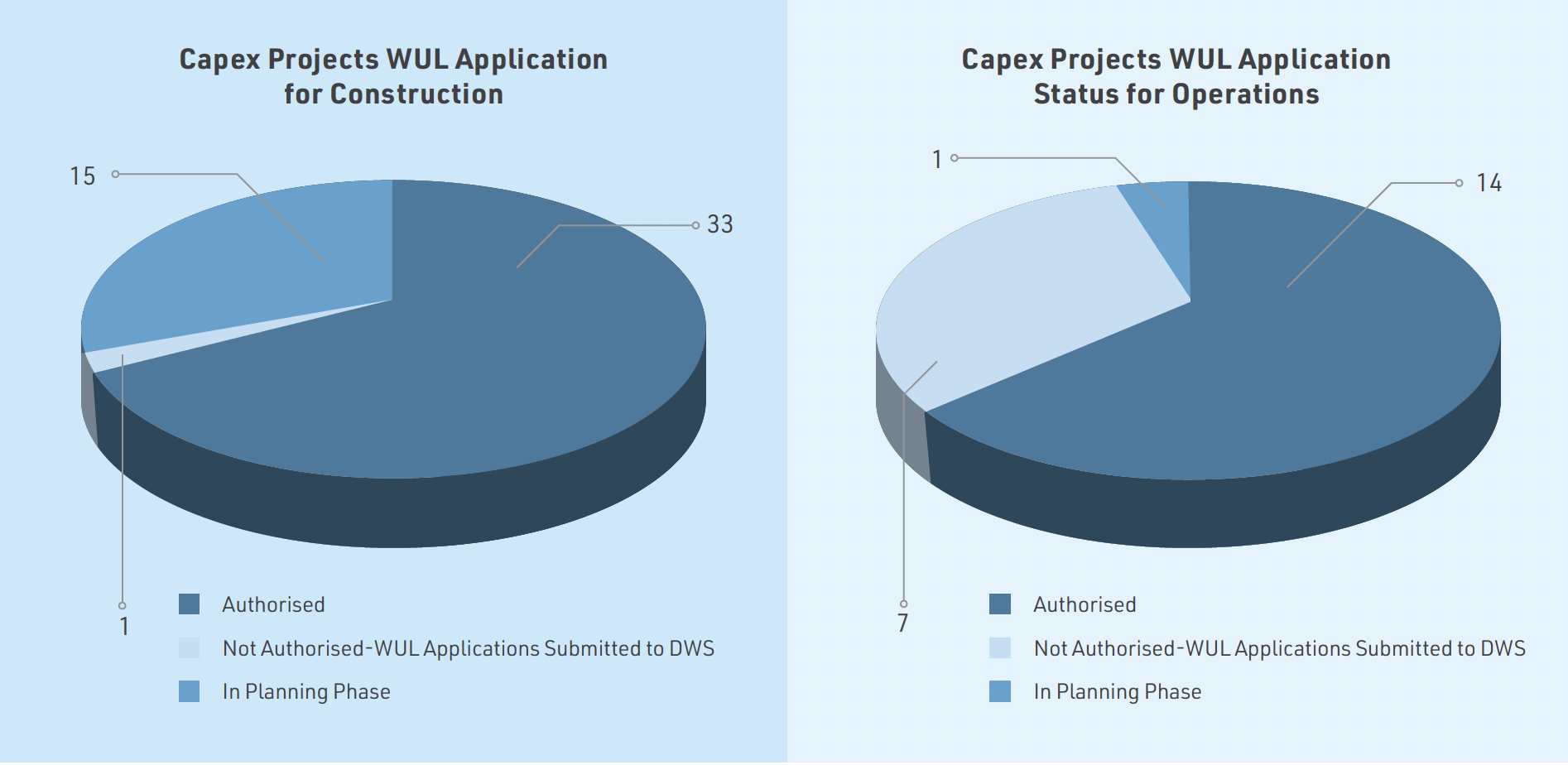
The Status of Water Use Licences for Operational Water Uses (existing water uses) is presented in the figure below:
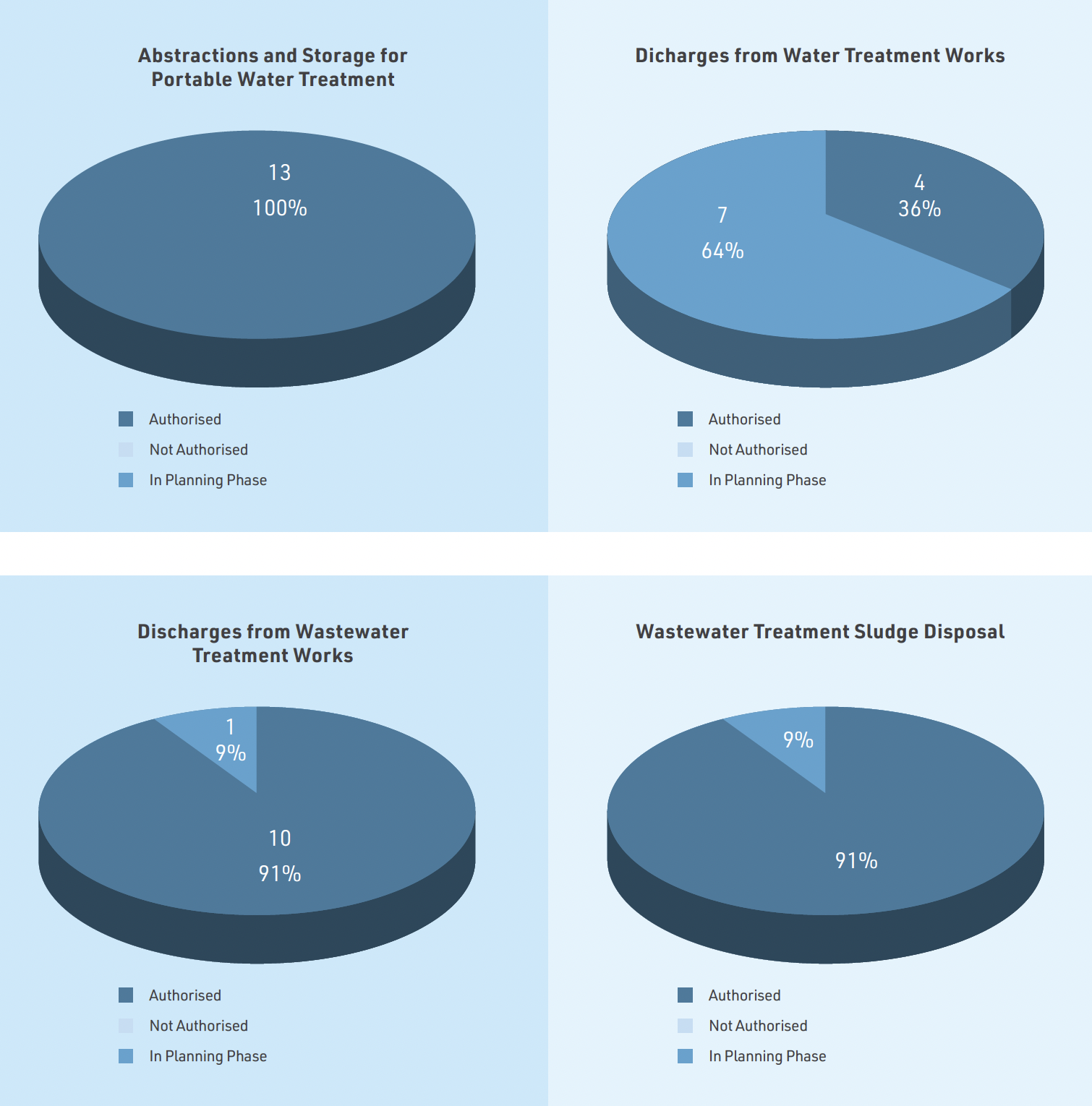
A comprehensive audit assessing compliance with Water Use Licence (WUL) conditions was conducted and finalized in the 2023/2024 reporting year. The non-compliances raised were mainly due to issues related to flood damage and increased demand. An external audit of the Mhlathuze River abstraction license was completed and submitted to DWS. The audit revealed a few minor issues, such as the need to remove alien plants, which can be resolved through regular daily operations. Collaborative efforts are in progress to rectify these issues, these include maintaining a communication with DWS, and ensure continuous improvement in all of UUW operational sites.
In terms of the offshore discharge system, UUW is compliant with most of the permit conditions. The only challenging area is that of quality compliance due to poor performing Contributors. The problematic Contributors have been identified and have been requested to put together a project plan that seeks to address these compliance issues. The plan is monitored quarterly as well as through frequent engagements with the relevant contributing industries. The authorities are also kept updated on the performance offshore in terms of effluent volumes, quality as well as in the case of Section 30 incidents.
In terms of the non-compliance with water use licence abstraction limits in the the Mngeni System, uMngeni-uThukela Water assisted uMsunduzi and eThekwini Municipality to develop a plan of action to reduce their water demand volumes within a period of 6 months from 10 October 2023 to 10 April 2024. The action plan also indicated that, should any of the Municipalities fail to reduce their planned demand within six (6) months, uMngeni-uThukela Water will have to curtail water supply at the water treatment plans to force compliance with the licence limits. Regarding progress, uMsunduzi Municipality has done well in reducing its demand, while eThekwini Municipality’s demand is still well above their planned reduced demand due to procurement related reasons. The eThekwini Municipality submitted a motivation to DWS to extend their 6-month grace period so they can be able to finalise procurement and implement water demand interventions. DWS granted eThekwini an extension up to October 2024 to reduce their demand before UUW can curtail supply at the water treatment works.
Msinsi Holdings SOC Ltd, a wholly-owned subsidiary of uMngeniuThukela Water, is mandated to manage the land and biodiversity of the areas around the dams owned or managed by uMngeni-uThukela Water in a manner that balances the divergent factors of local community development provision of recreational facilities for the public and water resources/biodiversity protection.
These reserves are located at:
The following sites have been incoporated into the scope of Msinsi for
implementing catchment management inteventions associated with
alien invasive plant eradication:
Detailed management plans for each of the reserves in line with
industry best practice have been completed and form the basis for
all operations in the reserves. In the past year, Msinsi succeeded in
protecting the habitats and ensuring an ecological sustainable and
protected water environment through implementing its resource
management plans which focused on:
The ecological balance was managed effectively during this period through the implementation of Reserve Management Plans. In particular,carrying capacity was managed to ensure sustainability of wildlife populations and measures to mitigate poaching, which has been a significant threat to the reserve wildlife, were put in place.
Security patrols are conducted as per a patrol plan to identify and mitigate security risks to the reserves including ensuring reserve fence lines are in good condition.
Msinsi Holdings continues to be seen as a significant player in the conservation and tourism sector in KwaZulu-Natal. The state-owned company will continue to ensure that ecosystem services provided by water and environmental resources continue to be sustainable.
Stakeholder engagement successfully created value for Msinsi’s operations and the communities at large during this reporting period. As a result, there was no interruption of Msinsi’s operations as a result of community instability in the neighbouring areas.
uMngeni-uThukela Water’s waste management approach centres on complying with applicable regulatory requirements and adhering to circular economy principles. uMngeni-uThukela Water’s commitment to environmental sustainability and the circular economy is documented in the Environmental Sustainability Plan. The initiatives aim to transform the organisation from the typical wasteful linear economic model (take-make-use-dispose) to an economic model that enables economic growth, while aiming to optimise the operation chain in a more sustainable approach. Waste minimisation was identified as one of the crucial initiatives in reducing the amount of waste that is disposed at landfill sites. Therefore, a target was set in 2023/2024 to divert five percent (5%) of the waste from the landfill sites through recycling.
A significant increase of waste diverted from landfill through recycling was observed during 2023/2024 (Figure 11.6 and 11.7). The reported recyclable waste was 10.47% which is above the target of 5%. There were a number of recycling initiatives that were employed by uMngeni-uThukela Water including separation of the waste from source, 3 in 1 recycling bins and placed in strategic positions.

uMngeni-uThukela Water continues to support SA’s recycling businesses. These businesses do not only remove waste in the form of glass, paper, plastic and other non-biodegradable materials from the environment, but also create work for many families that collect and sell waste to recyclers. Recycling also creates alternative income streams for factories where waste materials may be sold to recycling entities rather than being dumped in landfills.
Management and disposal of sludge and water treatment residues remains a critical issue across uMngeni- uThukela Water operation. Current sludge management practices include on and off-site disposal and river discharges. These current practices are not sustainable due to increasing costs, limited space, environmental concern, and the required legislative requirements. As a result, uMngeni-uThukela Water developed a comprehensive Sludge Management Plan (SMP) for its operational sites.
The water treatment residues will be applied to agricultural land as a soil conditioner whilst the wastewater sludge will be used as organic compost. Land application of water treatment residues offers a sludge management option with potential benefits when applied to soil. The application of water treatment residues to the land helps conserve landfill disposal capacity and natural resources.
Wastewater sludge contains organic matter and nutrients that can provide soil benefits. Preliminary process designs for both options were concluded during the year under reviewland acquisition is for the process yet to be concluded.

Annual environmental audits are undertaken at operational sites the objectives, which are:
In the year under review, there were 12 environmental incidents recorded for the 2023/2024 financial year. This indicates a stable performance in the number of incidents from the previous year. Figure 11.8 provides the comparative analysis for the past five years.
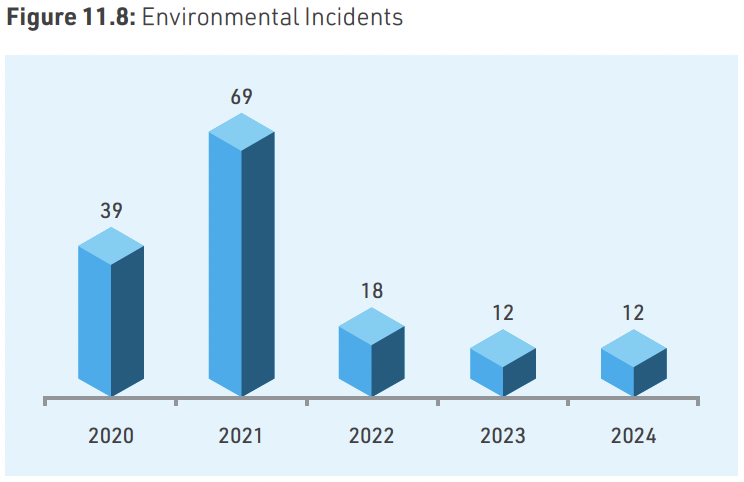

uMngeni-uThukela Water’s core business function is to provide water services – water supply and sanitation services – to other water services institutions. Business relies highly on the natural resource, which is freshwater resources, although there has been measures to venture into other sources of water. In this regard, the natural environment is core to uMngeni-uThukela Water. The assessment and management of environmental aspects, which could arise from the development of new infrastructure projects, is managed through the integrated environmental management system (IEM).
The IEM is a philosophy that is concerned with finding the right balance between development and the environment and provides an overarching framework for the integration of environmental assessment and management principles into environmental decision-making.
The IEM system has various tools, which can be applied at different stages of the activity life cycle such as planning, design, construction, operations and closure. They include conducting environmental screenings, environmental impact assessments (EIAs), Environmental Management Plans (EMPs), auditing, and specialist inputs.
uMngeni-uThukela Water utilises the EIA tool governed by the provisions of the National Environmental Management Act, 107 of 1998 (NEMA) which stipulates that projects triggering listed activities as stipulated in the regulations are required to obtain an environmental authorisation (EA) either through a basic assessment (BA) or a scoping and full environmental impact assessment process (EIA). Where project developments do not trigger listed activities as defined in the Act, the environmental screening and EMP tools are utilised to ensure that all the potential environmental impacts emanating from project implementation are eliminated or minimised to acceptable levels.
In the previous financial year, a total of 31 projects were in the Planning or Design phases. During the current reporting period of 2023/2024 , 25 projects were in the Planning or Design phase:
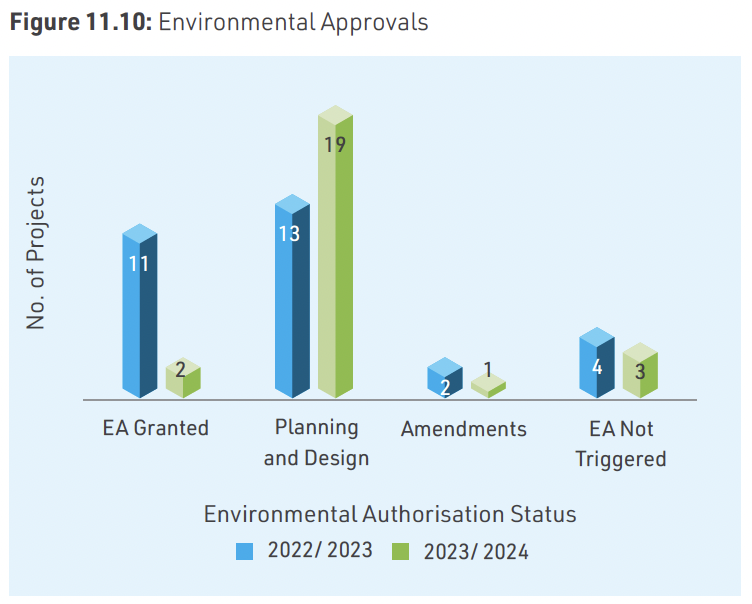
At the beginning of the 2023/2024 financial year, the organisation had a total of 19 projects that were in the construction phase and had obtained all the required environmental authorisations and permits. As the year progressed, the number of projects increased to 25 projects in the construction phase at the end of the 2023/2024 financial year. During the financial year, environmental audits were conducted and environmental compliance was monitored.

| Risk Rating | No. of Findings | Percent (%) |
|---|---|---|
| Minor | 16 | 57 |
| Major | 12 | 43 |
| TOTAL | 28 | 100 |
